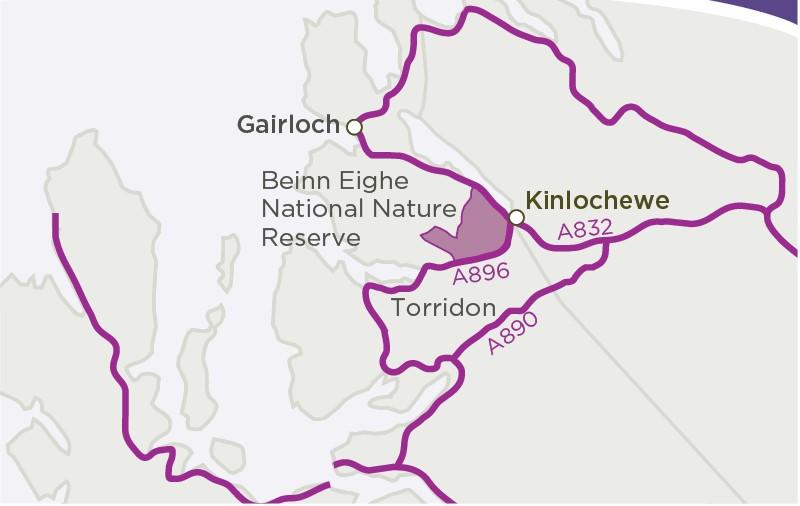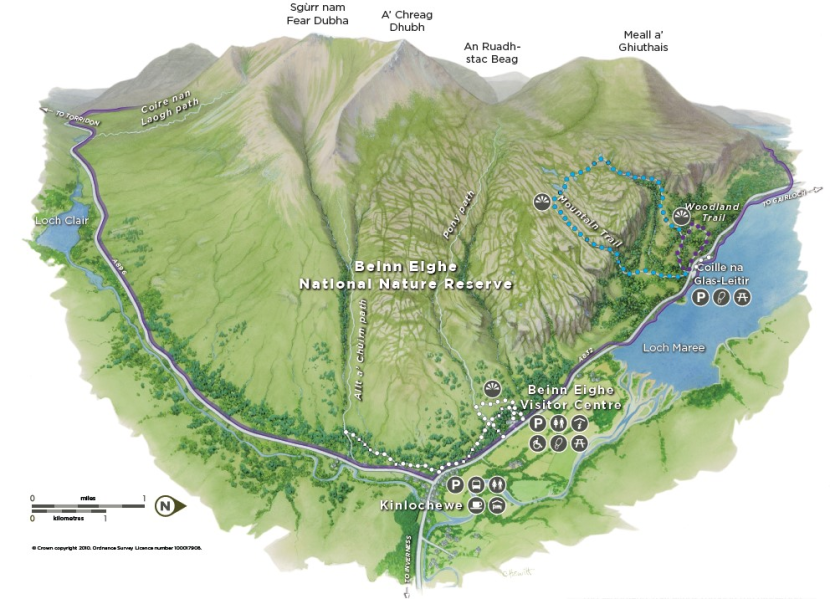Beinn Eighe NNR - visiting the reserve leaflet
Read in Gaelic / Leugh ann an Gàidhlig
Welcome to Beinn Eighe National Nature Reserve
Sands of time
Some 800 million years ago, massive rivers began to dump sand and gravel over the ancient bedrock. Piling up to six kilometres thick, these sediments became the Torridonian sandstone that forms the bulk of Beinn Eighe and neighbouring mountains.
Around 400 million years ago, major movements of the Earth’s crust drove a large slice of Torridonian sandstone upwards to come to rest on younger quartzite rocks. This reversal of the usual sequence (where older rocks sit below more recent ones) is one of the reasons for Beinn Eighe’s great geological interest.

Insects and all
Abundant midges can mean there’s no escaping the insect life here. But meeting some of the Reserve’s hundreds of other kinds of insects – many of them rare and unusual – is much more pleasant.
In summer, look out for golden-ringed dragonflies and the beautifully coloured blue aeshna. A moth flying in crazy zigzags over the heather could be a male northern eggar, trying to home-in on the scent of a female. The caterpillars of this moth and some other common ones are very hairy as protection against predators. So look, but don’t touch!

Small is beautiful
More than 500 metres up the mountain slopes, a dense cover of tough plants hugs patches of ground. Dwarf willow and prostrate juniper rise only a few centimetres above the surface. while fir and alpine clubmosses sprout among small sedges.

This dwarf shrub heath, as botanists call it, is one of the finest of its kind in Britain. Similar to the vegetation found on the arctic tundra, its presence here shows just how severe the exposure can be way up the Beinn.
Grannies of the grey slope
One of the most westerly fragments of ancient Scots pinewood survives at Beinn Eighe on the Glas Leitir (grey slope). Some of its seed trees, or ‘granny’ pines, are more than 350 years old. But their ancestral roots go much deeper. Scots pines arrived here around 8200 years ago. This was long after the last Ice Age glaciers – which scooped out the hill corries and the trough now filled by Loch Maree – had melted.

Beinn Eighe National Nature Reserve lies at the southeast end of Loch Maree near the village of Kinlochewe. It can be accessed from both the A832 and the A896. Contains Ordnance Survey data © Crown copyright and database right 2021
Find out more
- tel 01463 701660 or email [email protected]
- Support this NNR at nature.scot/donate-nnr
- Follow @beinneigheNNR on social media
-
Visiting the reserve, getting involved and about the reserve

On the trail of the ancient pines
The Woodland Trail winds through the pinewood for about 1½ kms, whilst the Mountain Trail leaves the pinewood and climbs the hillside. Walking the whole 6½ kms trail takes three or four hours, and stout footwear is recommended. But a trek along even a small part of it can be fun.

Buzzards, golden eagles and ravens can be spotted on the Trail and you may even be lucky enough to see pine martens and wildcats. For visitors who would like to find out more about Beinn Eighe, there’s a visitor centre open from Easter to October just outside Kinlochewe, and three all-ability trails that are open all year.
Reserve map

- Parking
- Bus stop
- Accessible facilities
- Toilet
- Information centre
- Mountain Trail
- Woodland Trail
- Visitor Centre Trails
- National Nature Reserve
- Picnic area
- Viewpoint
- Refreshments
- Accommodation










